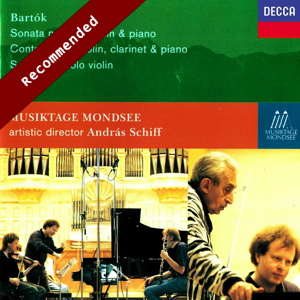
Béla Bartók (1881-1945)
Sonata No. 1 for violin and piano (1921)
10 Duos (from 44 Duos for two violins) (1931)
Sonata for two pianos and percussion (1937)
Yuuko Shiokawa, Lorand Fenyves, Hans Heinz Schneeberger (violins)
András Schiff, Bruno Canino (piano)
Zoltan Rácz, Zoltan Vaczi (percussion)
rec. 1993/1994, Grosser Saal, Mozarteum, Salzburg, Austria
Presto CD
Decca 443894-2 [74]
The First Violin Sonata is among Bartók’s toughest, most uncompromising works. Its opening is intensely rhapsodic, with suggestions of the cimbalom in the piano-writing. The tempo marking is Allegro appassionato, a quality which Ms Shiokawa ideally captures, but a passage in the middle of this dramatic sonata-form movement is an oasis of calm and inwardness, its timelessness perfectly evoked, before the vigorous dotted rhythm reasserts itself. This is difficult music, undoubtedly, but it grips my attention throughout, largely due to the superb performance. In the central, ternary-form Adagio Ms Shiokawa (András Schiff’s wife) is sparing with her vibrato, to great effect. I find the profound serenity of this movement not unlike the middle movement of the Third Piano Concerto in its effect, both strange and beautiful. Here, reversing the contrast of the opening movement, the middle section is more intense, dominated by the violin’s double-stopping. The husband and wife create a rare magic. In the rondo finale Bartók evokes folk-dances – including Transylvanian and North African, according to the booklet notes – without a single borrowing. This originality should not surprise us, however, as Bartók’s thorough assimilation of folk idioms into his own language is well-known. Again this duo partnership’s performance inspires total admiration. So much for the stereotyped notions of Japanese musicians as cool, detached or bland.
The Sonata for two pianos and percussion is one of Bartók’s very greatest works and one of the twentieth century’s masterpieces. The players’ progress from the mysterious Assai lento (with violent interruptions) into the Allegro molto, including two accelerandos, is ideally judged, the new tempo exploding upon us. Though the movement’s predominant characteristic is driving energy, Bartók, in common with all the greatest composers, has a multi-faceted musical personality, accommodating a wide range of expressive contrasts. In this extended movement there are dolce and tranquillo passages, as well as other scherzando episodes and a maestoso. For many listeners, sadly, the aggressive, uncompromising side of Bartók is the first one – sometimes the only one – which comes to mind. In this performance I feel that these contrasts could not be more beautifully drawn.
Lento ma non troppo is the marking for the middle movement, the non troppo being well observed here. This simply does not need to be any slower to enable the atmosphere and stillness to register. The persistence of the six-note rhythmic figure crescendos superbly and the subsequent calming is conveyed with equal control, before the pianos’ passage of rapid chromatic scales is mesmerisingly played.
In the finale, which shows the composer at his most genial and diatonic, this performance is delightfully unbuttoned. Altogether Schiff and company give a tremendously satisfying account – ranging from electrifying to serenely relaxed – of this fantastic piece. For obvious reasons, one will hear it in live performance quite rarely, so we have to make the most of a CD such as this. Of course, there are other essential recordings – for example Argerich and Freire – but in my book there is usually room on the shelf for at least two or three CDs of a classic. I generally dislike the idea of a “winner”.
The Duos which form the centrepiece of the CD are a selection of ten from the complete sequence of forty-four. Bartók never intended players to perform the whole set nor to adhere to the original order. These are miniatures, but not trifles – pieces of real substance and character. The hand of a master is as evident here as it is in the successive books of Mikrokosmos. The well contrasted selection here includes the brilliantly imaginative Mosquito Dance (38 seconds), Sorrow, Pizzicato and Transylvanian Dance.
The booklet includes a sepia photograph of the attractive location of Mondsee, which strongly supports Schiff’s belief that “in beautiful surroundings, away from the pressures of everyday life, most people feel better able to appreciate art and music”. (From his own booklet note about Mondsee Festivals). László Somfai has written the main booklet note, which is excellent. Achieving the ideal recorded balance between pianos and percussionists is not at all straightforward, but I cannot fault the results in this performance.
Philip Borg-Wheeler
Help us financially by purchasing from



















